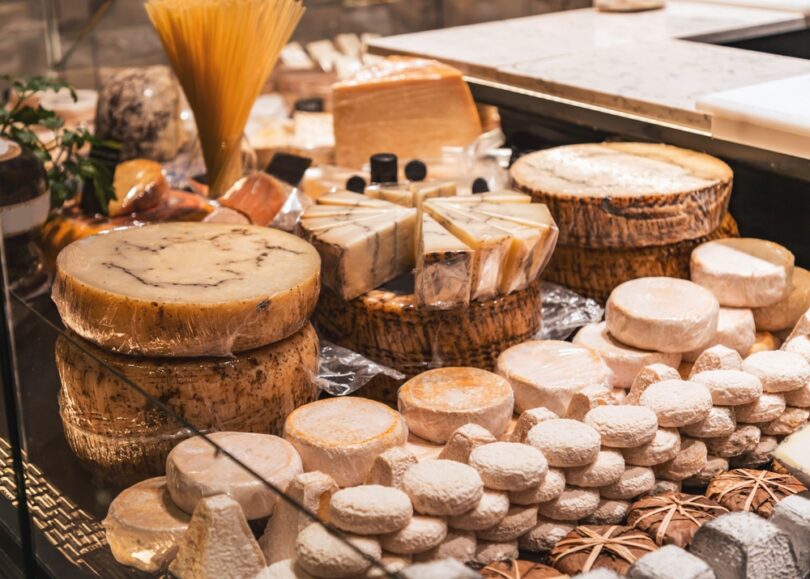Embark on a gastronomic journey through France, where cheese is not just a culinary delight but a cultural symbol. This cheese tour weaves through France’s distinctive regions, each famed for their own distinctive cheese, rooted in a rich history. The story of French cheese is a tale as old as time, tracing back to ancient farmstead traditions, now evolved into an esteemed artisanal craft recognized globally. Boasting over a thousand varieties, French cheese mirrors the country’s diverse geography, from Normandy’s verdant valleys to the sun-kissed hills of Provence.
This tour offers more than a chance to savor legendary cheeses like Camembert, Roquefort, and Munster. It’s an invitation to immerse in France’s breathtaking natural beauty, historic richness, and vibrant culture. Here, the joy of cheese is harmoniously paired with another of France’s renowned treasures – wine. With its status as a celebrated wine destination, France provides an exquisite backdrop for exploring the perfect pairings of cheese and wine. This journey promises a delightful fusion of culinary excellence, scenic beauty, and vinous adventure. Whether a cheese enthusiast or a travel lover, France’s cheese tour is an all-encompassing experience of taste and tradition.

Camembert
Normandy — Camembert
In Normandy, the birthplace of Camembert, cheese is more than just a delicacy; it’s a symbol of the this lush, northern area of France. With its verdant pastures and mild climate, Normandy offers the ideal conditions for producing Camembert, with its creamy, soft texture and earthy, rich flavor. As you travel through the various places in Normandy that produce Camembert, the route takes you on a picturesque journey through quaint villages and traditional farms, places where the art of cheese-making has been passed down through generations. The serene, rolling countryside is dotted with traditional half-timbered houses and sprawling apple orchards.
Along this picturesque path, travelers encounter charming, small-scale cheese producers, each offering a particular insight into the art of Camembert making. Here, you can witness the meticulous process of hand-ladling, which gives Camembert its distinctive character. Visitors can pair tastings of this world-renowned cheese with local ciders and wines, particularly the apple-based Calvados or the delicate, fruity notes of a Pays d’Auge wine, which nicely complement the cheese’s creamy profile.
Languedoc-Roussillon — Roquefort
In the heart of Languedoc-Roussillon lies the cradle of Roquefort, a cheese as storied as the region itself. This southern French locale, with its rugged terrain and contrasting landscapes, from the windswept Causse plateaus to the lush valleys, creates the perfect environment for the famous Roquefort cheese. Made from the milk of ewes grazing on these diverse pastures, Roquefort is known for its complex, tangy flavor and distinct blue veins, a result of the Penicillium roqueforti mold.
Roquefort’s journey begins in the natural limestone caves of Roquefort-sur-Soulzon, where the cheese is aged to perfection. These caves provide a distinctive microclimate with constant humidity and temperature, crucial for developing Roquefort’s signature taste and texture. Visitors to the region can explore these ancient caves, witnessing firsthand the meticulous aging process that transforms the cheese into a creamy, flavorful delicacy. Paired with local wines, such as a robust Languedoc red or a crisp white from Roussillon, Roquefort offers a taste of the land’s history and the artisanal skills honed over centuries.

Roquefort
Alsace and Lorraine — Munster
Alsace and Lorraine, regions known for their cultural blend, are the proud producers of Munster cheese, a culinary pleasure with deep roots in the local heritage. Nestled between the Vosges mountains and the Rhine river, these regions offer a picturesque setting for the production of Munster, a cheese beloved for its strong aroma and smooth, creamy texture.
This cheese, traditionally made from the milk of Vosgienne cows, offers a bold flavor, ranging from mildly tangy to pungently assertive. This distinctive taste is a direct result of the skilled craftsmanship and aging process it undergoes in local affineurs’ cellars. Visiting Alsace and Lorraine offers a chance to experience Munster in its authentic environment. Pairing it with local specialties like flammekueche (a thin-crust pizza) or a glass of Gewürztraminer or Pinot Gris really brings out the cheese’s flavor profile.
Loire Valley — Valençay, Crottin de Chavignol, Sainte-Maure de Touraine
The Loire Valley, often referred to as the “Garden of France,” offers an enchanting backdrop for the discovery of its exquisite cheeses: Valençay, Crottin de Chavignol, and Sainte-Maure de Touraine. Although this region is famous for its breathtaking châteaux and vibrant vineyards, it is also a haven for cheese enthusiasts.
Valençay, with its distinctive truncated pyramid shape and ash-covered rind, is a visual and culinary delight. Its subtle, nutty flavor evolves beautifully with age. Crottin de Chavignol, one of the oldest French cheeses, small but mighty, captivates with its intense, goaty aroma and strong taste. Then there’s Sainte-Maure de Touraine, which offers a creamy texture and a slightly tangy finish. Tasting these cheeses in the Loire Valley, especially when paired with local wines like Sancerre or a Vouvray, is an experience that transcends the palate.
Roughly 2 hours from Paris, the Loire Valley also features numerous majestic châteaux, from the Renaissance splendor of Château de Chambord to the romantic allure of Château de Chenonceau, which elegantly arches over the Cher River. The valley’s rolling vineyards, tranquil rivers, and picturesque villages are a canvas of serene beauty, while its art galleries and festivals showcase a vibrant cultural heritage. This combination of tempting culinary offerings with both natural and human-made beauty make Loire Valley a must-visit destination on any French cheese tour.

Epoisses
Burgundy — Epoisses
Burgundy is a region synonymous with world-class wines and culinary heritage, but it is also the home of Epoisses, a rich cheese known for its creamy, melt-in-the-mouth texture and strong, aromatic character. Produced in the quaint village of Époisses, this cheese is lovingly washed in Marc de Bourgogne, a local pomace brandy, during its maturation process. This treatment imparts a distinctive pungent aroma and a deep, complex flavor profile to the cheese. The result is a soft, reddish-brown rind encasing a luscious, creamy interior that becomes more gooey and intense with age.
Experiencing Epoisses in Burgundy is not just about tasting the cheese but also about immersing in the region’s rich history and culture. The scenic beauty of rolling hills, lined with vineyards and dotted with historic châteaux and medieval towns, provides a perfect backdrop for indulging in Epoisses. Paired with a glass of Burgundy wine, such as a Chablis or a Pinot Noir, Epoisses becomes an integral part of the Burgundian culinary adventure
Rhone-Alpes — Reblochon, Beaufort, Tomme de Savoie
The Rhone-Alpes region, a mixture of stunning alpine scenery and culinary richness, is the proud origin of some of France’s most celebrated cheeses: Reblochon, Beaufort, and Tomme de Savoie. This region, with its clear mountain air and lush pastures, provides the perfect environment for cheese production.
Reblochon, known for its creamy texture and nutty aftertaste, is a product of traditional dairy farming techniques. This cheese, with its orange rind and supple interior, embodies the rustic charm of the Alpine countryside. Beaufort, often called the “Prince of Gruyères,” stands out with its smooth, firm texture and subtle, sweet flavor. Tomme de Savoie has a distinct gray rind and semi-firm texture, and offers a milder flavor profile, characterized by earthy notes.
The cheese experience in the Rhone-Alpes region is nicely complemented by the region’s full-bodied Côtes du Rhône red wines and the hearty local cuisine, featuring rich stews and charcuterie.
You Might Also Enjoy: Gift the Gift of Vino! The Ultimate Wine Tours to Give — or Get!

Tomme de Savoie
Auvergne — Bleu d’Auvergne, Saint-Nectaire, Fourme d’Ambert, Cantal
Auvergne, a region of dramatic volcanic landscapes and ancient heritage, is also known for its array of distinctive cheeses like Bleu d’Auvergne, Saint-Nectaire, Fourme d’Ambert, and Cantal. Bleu d’Auvergne, with its creamy texture and spicy blue veins, offers a bold flavor, arising from the natural grasses and wildflowers of Auvergne’s pastures. Saint-Nectaire, a semi-soft cheese with a smooth, velvety texture and subtle, nutty taste, reflects the mineral-rich soil of the region. Fourme d’Ambert, one of France’s oldest cheeses, has a mild, creamy profile with hints of mushroom and earthy undertones. Cantal, a firm cheese akin to aged cheddar, boasts a complex flavor palette ranging from milky sweetness to a sharp, tangy bite.
The rugged charm of Auvergne, with its sweeping highlands and historic villages, creates the perfect backdrop for savoring these cheeses. The region’s rustic cuisine, often featuring hearty stews and locally sourced ingredients, alongside distinctive wines like the bold reds from Saint-Pourçain, make Auvergne a great addition to any French cheese tour.
FAQs:
Q: What is the best time of year to embark on a French cheese tour?
A: Spring and early autumn are ideal for a cheese tour in France. These seasons offer mild weather, scenic beauty in full bloom or harvest, and fewer tourists. Cheese festivals and markets are also more frequent during these times, offering a richer experience.
Q: Are there guided cheese tours available, or should I plan my own itinerary?
A: Both options are available. Guided tours offer structured itineraries with expert insights, ideal for those seeking a comprehensive experience. However, planning your own itinerary allows for more flexibility and personalization. Many regions have visitor centers that provide maps and information for self-guided tours.
Q: What language barriers can I expect, and how should I prepare?
A: While major tourist spots and larger cities in France have English-speaking locals, rural areas might present a language barrier. Learning basic French phrases or using a translation app can enhance your experience. It’s also helpful to have a French cheese glossary handy.
Q: Are there any specific etiquette or customs I should be aware of when visiting cheese producers?
A: When visiting cheese producers, it’s respectful to ask permission before taking photos. It’s also customary to taste the cheese offered to you, and while purchasing is not obligatory, it’s a nice gesture to support local artisans.
Q: Can I bring back French cheese to my home country?
A: This depends on your home country’s customs regulations. Many countries allow the import of hard and semi-soft cheeses, but restrictions on raw milk cheeses are common. Check your country’s customs guidelines before purchasing cheese to bring back.
Q: What are the options for accommodation along the cheese routes?
A: Accommodation options vary from luxury hotels and chateaux to quaint bed-and-breakfasts and rural farm stays. Booking in advance is recommended, especially during peak seasons, to ensure a stay that complements your cheese tour experience.
Q: Is it necessary to rent a car for a cheese tour in France?
A: While some regions are accessible by public transport, renting a car offers greater flexibility, especially for exploring rural areas and small cheese-producing farms. A car allows you to travel at your own pace and visit off-the-beaten-path locations.
Have you ever visited any of these cheese-producing regions of France? Tell us about it in the comments below!








